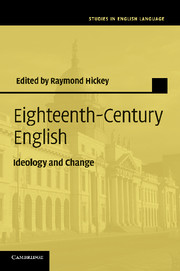Book contents
- Frontmatter
- Contents
- List of figures
- List of maps
- List of tables
- Notes on contributors
- Preface
- 1 Attitudes and concerns in eighteenth-century English
- 2 Prescriptivism and the suppression of variation
- 3 Women's grammars
- 4 Eighteenth-century women and their norms of correctness
- 5 Lowth as an icon of prescriptivism
- 6 Queeney Thrale and the teaching of English grammar
- 7 Coalitions, networks, and discourse communities in Augustan England: The Spectator and the early eighteenth-century essay
- 8 Contextualising eighteenth-century politeness: social distinction and metaphorical levelling
- 9 Expressive speech acts and politeness in eighteenth-century English
- 10 Variation and change in eighteenth-century English
- 11 Variation in sentential complements in eighteenth- and nineteenth-century English: a processing-based explanation
- 12 Nationality and standardisation in eighteenth-century Scotland
- 13 English in eighteenth-century Ireland
- 14 Changes and continuities in dialect grammar
- 15 ‘Be pleased to report expressly’: the development of a public style in Late Modern English business and official correspondence
- 16 Registering the language – dictionaries, diction and the art of elocution
- Timeline for the eighteenth century
- References
- Late modern English language studies
- Indexes
12 - Nationality and standardisation in eighteenth-century Scotland
Published online by Cambridge University Press: 06 December 2010
- Frontmatter
- Contents
- List of figures
- List of maps
- List of tables
- Notes on contributors
- Preface
- 1 Attitudes and concerns in eighteenth-century English
- 2 Prescriptivism and the suppression of variation
- 3 Women's grammars
- 4 Eighteenth-century women and their norms of correctness
- 5 Lowth as an icon of prescriptivism
- 6 Queeney Thrale and the teaching of English grammar
- 7 Coalitions, networks, and discourse communities in Augustan England: The Spectator and the early eighteenth-century essay
- 8 Contextualising eighteenth-century politeness: social distinction and metaphorical levelling
- 9 Expressive speech acts and politeness in eighteenth-century English
- 10 Variation and change in eighteenth-century English
- 11 Variation in sentential complements in eighteenth- and nineteenth-century English: a processing-based explanation
- 12 Nationality and standardisation in eighteenth-century Scotland
- 13 English in eighteenth-century Ireland
- 14 Changes and continuities in dialect grammar
- 15 ‘Be pleased to report expressly’: the development of a public style in Late Modern English business and official correspondence
- 16 Registering the language – dictionaries, diction and the art of elocution
- Timeline for the eighteenth century
- References
- Late modern English language studies
- Indexes
Summary
The modern Scots visitor to Rome's delightful little Piazza SS Apostoli must surely view the scene with a strong feeling of poignancy, for it was to apartments in a small pallazzo in that square (no. 49) that Charles Edward Stewart repaired for sanctuary after his disastrous defeat at the hands of a government army (largely composed of Scots) on the moor of Culloden in 1746. The effects of that debacle were, of course, wide-reaching in social, economic and political terms, but the defeat of the Jacobite armies also had enormous consequences for the languages of Scotland. Perhaps the most wide-ranging was the effect on the Gaelic language, henceforth subject to deliberate suppression, leading to its serious decline which has lasted to this day. But there was also a less immediate effect on the language spoken in non-Gaelic Scotland – the Lowlands with their large cities as well as the North Eastern counties with large population centres at Aberdeen and Dundee. This form of speech, usually described by contemporaries as Scotch or Scots, was itself also subject to pressures from a variety of sources throughout the eighteenth century, especially in its latter stages. Hostility to all things Scottish was a feature of post-1746 England. For instance, in his entry of 8 December 1762 in his London Journal James Boswell observes: ‘At night I went to Covent Garden and saw Love in a Village, a new comic opera … Just before the overture began to be played, two Highland officers came in.
- Type
- Chapter
- Information
- Eighteenth-Century EnglishIdeology and Change, pp. 221 - 234Publisher: Cambridge University PressPrint publication year: 2010
- 3
- Cited by



